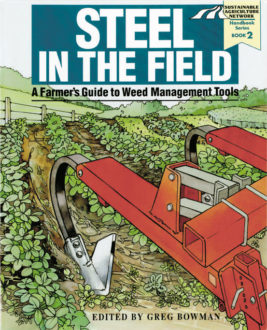ABCs of Mechanical and Cultural Weed Management
B. Keep weeds on the defensive.
Weed seeds wait each spring for heat and light to induce germination. Don't wake them up unless you have a way to take them out.
Several farmers in this book describe their version of a 'stale seedbed.' (See stories about Jim Cavin, Rich de Wilde, Carmen Fernholz and Paul Muller.) They do one or two shallow tillage passes to stimulate germination of surface weed seeds before crop-planting time. Irrigation or warm, moist soil conditions spur weed seed germination that triggers a control pass with tillage or flame. By minimizing subsequent tillage at planting that would stimulate new weed seeds, the crop comes up through pre-weeded soil.
Any planter can be less of a weed-helper if it is tooled to leave soil as loose as possible over the seed row, while still creating good seed-soil contact. Packer wheels at the surface press light-stimulated weed seeds into moisture. Ridge-till planters move fresh weed seed from the rows by skimming the top inch or so of topsoil from the row to the middles, where cultivators can attack weeds more easily.
Your crops can out-compete weeds through well-planned crop rotations. Manage the crop sequence to minimize ecological openings for weeds. Mix crop rooting depth, root type (taprooted or fibrous), and seasonal surface cover. Vary the timing and depth of tillage. In mature, sophisticated rotations, crops emerge in ideal conditions while weeds struggle to find an opening to survive.
C. Accept weeds that don't really matter.
Separate how you feel about weeds in your fields from their potential to diminish production. Agronomically, weeds are an economic problem only if they decrease yield - now or in the future - by more than the cost of managing them. If the aesthetics of a clean field are important, you need to be honest about the extra cost.
Weed species vary in how much of a threat they pose to crop vigor. Some winter annuals provide soil protection. Some annual weeds in forage crops provide nutrition for livestock or abundant residue to build soil. Weeds that don't go to seed in a cover-crop stand count as biomass to soil microbes and warrant only your watchful eye. '
Eradication of all weeds is a virtual ring in the nose of farmers,' claims organic farmer Terry Jacobson of Wales, ND. That goal can tempt farmers to over-control with chemicals or excess tillage, he says.
Jacobson wants to learn more each season about weeds. He wants to know which ones he can live with, which ones are worth containing and which ones are telling him where he needs to make improvements in crop or soil management.
